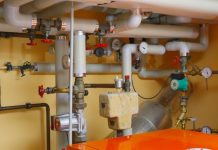
When we think about tornado damage, we picture shattered roofs and twisted trees, but the impact doesn’t stop there. Tornadoes can seriously degrade air quality both outdoors and indoors, creating hidden health risks that linger long after the storm has passed. For homeowners and HVAC professionals alike, understanding how these violent storms affect airflow, filtration, and contamination is critical to maintaining safe, breathable air.
Tornado Impact on Airflow and Debris Spread
A tornado is essentially a violently rotating column of air extending from a thunderstorm to the ground. Inside the funnel, wind speeds can exceed 200 mph, creating an intense low-pressure core. This pulls surrounding air inward and upward in a spiral, like a giant vacuum. It’s not just a horizontal windstorm, it’s a vertical engine that rips air from the surface and injects it into the storm system above.
As the vortex touches down, it acts like a massive blender: it lifts dirt, dust, moisture, chemicals, building materials, vegetation, and even animals into the air. Everything in the tornado’s path becomes airborne. Some of that debris doesn’t come down for hours, or even hundreds of miles. What most people don’t realize is that the tornado’s violent updraft acts like a conveyor belt, pulling ground-level particles into the upper atmosphere and reshaping the boundary between the earth and the sky. This specific tornado impact contributes significantly to how particles travel far beyond the original storm zone.
Tornadoes can create “dirty air columns”, not just with debris you can see (wood, metal, soil), but with invisible, micron-sized contaminants that behave like wildfire smoke. They ride the storm system until gravity or rain drags them down, sometimes far from the original site. This redistribution isn’t random, it can follow patterns based on air pressure ridges and jet stream behavior, amplifying long-range tornado effects.
How Do Tornadoes Affect The Environment?
Tornadoes are surgical yet violent, they can devastate one area while leaving a neighboring region untouched. Here’s how they affect the environment:
Immediate impact: Trees are uprooted, soil is stripped, crops are shredded, and wildlife habitats are destroyed. In agricultural areas, fertilizers, pesticides, and manure from farms can be spread across vast areas, turning what was a precision agriculture zone into a patchwork of unintended chemical exposure. This kind of environmental tornado impact can affect ecosystems for years.
They don’t just rip through landscapes, they rewrite ecological baselines. Post-tornado, you’re often looking at an accidental rewilding experiment: trees fall, light hits the forest floor for the first time in decades, and invasive species get a sudden opportunity. Localized microclimates may emerge if large portions of tree canopy are lost, altering shade, soil temperature, and water retention in affected areas.
Tornadoes can alter ecosystems by disrupting plant succession, redistributing invasive species, and polluting waterways with chemicals and debris. Another overlooked effect: the loss of carbon sinks. Tornadoes tear through mature trees that stored decades of carbon. Burned or broken trees also release carbon into the atmosphere. Multiply that across dozens of square miles, and you have a measurable tornado impact on local carbon cycles.
Tornado Impact On Airborne Pollutants
Tornadoes don’t just throw around furniture and fence posts. They can stir up and distribute a wide range of harmful particles and pollutants, both natural and man-made, making them a temporary but intense contributor to regional air contamination. These tornado effects aren’t just visible, they extend into the microscopic world of pollutants that affect respiratory health and indoor air quality.
Chemical residues from damaged industrial sites, heavy metals from vehicle fluids and roofing materials, and biological contaminants like mold spores, bacteria from sewage backups, or dead animal matter can all be swept into the air. Older neighborhoods and abandoned industrial areas pose additional risks, where a tornado may unearth legacy pollutants like asbestos, lead, PCBs, or arsenic that were long buried or encapsulated.
Combustion byproducts, such as soot or ash from fires ignited by downed power lines, add another layer of toxic exposure. And if a tornado passes over livestock facilities, it can loft zoonotic and agricultural aerosols, bacteria, viruses, and drug residues from animal waste, into nearby communities. That includes antibiotic-resistant strains, carried effortlessly across miles. These are serious tornado effects that persist beyond the obvious destruction.
Forget the typical “dust and debris” answer. Here’s what really matters: electrically charged micro-particles. As tornadoes churn, they can generate static charges that affect how particles clump and travel, allowing them to linger longer or reach higher into the atmosphere, where they can eventually affect indoor air quality when they settle.
How Can Tornadoes Affect Humans?
The aftermath of a tornado often feels apocalyptic not just because of the damage, but because the air itself changes. The air can become thick with fine particles (PM2.5), mold, pollen, and construction debris, all of which can inflame lungs and aggravate asthma, COPD, and allergies. If industrial or agricultural sites are damaged, people may also be exposed to airborne toxins without realizing it, especially dangerous for children, seniors, and those with chronic health issues. These hidden tornado effects are often the most harmful in the long term.
Air quality issues after a tornado aren’t just about breathing, they’re about cognitive health, long-term inflammation, and invisible exposure windows. Many people shelter in damaged homes where insulation, fiberglass, or mold spores are circulating due to compromised walls or HVAC systems. Exposure often happens indoors, not outdoors. Homes with breached insulation, exposed drywall, or damaged HVAC systems can quietly trap contaminants, making indoor air quality worse than outside even days later.
People with PTSD or high stress levels post-disaster are more vulnerable to inflammatory effects from airborne particulates, even if they’re not medically “at risk.” In some cases, these exposures trigger latent illnesses, mold toxicity, sinus infections, persistent coughs, that appear weeks after the storm, long after people think the danger has passed.
How Tornado Effects Worsen Air Pollution
Tornadoes can stir up settled particles from soil, roads, or industrial zones, reintroducing them into the atmosphere. Think of it as kicking up a dangerous layer of dust that had been lying dormant. But the destruction itself also creates pollution, fires, chemical leaks, fuel spills, broken buildings releasing construction dust and synthetic insulation fibers, and disrupted septic systems all add to the mix. These tornado effects can reshape the health landscape of entire communities.
In urban or industrial settings, these risks escalate dramatically. Tornadoes can inadvertently create “pop-up pollution zones” where none existed before. More critically, they reallocate pollution sources. When a storage tank leaks or an HVAC system fails, a tornado can turn a sealed hazard into an open-air risk. That’s not just worsening existing pollution, it’s a shifting tornado impact that can destabilize public health safeguards.
They also accelerate secondary pollution effects: mold blooms, volatile off-gassing from wet insulation, and slow leaks from compromised underground fuel tanks. These don’t appear in satellite AQI data, but they’re real, and they harm the people still living and working in the damage zone, especially in terms of indoor air quality deterioration.
The real danger is not the spike, it’s the shift.
Tornado Impact and Air Quality Duration
That depends on the severity of the damage, the weather that follows, and how quickly cleanup efforts begin. Here’s a rough timeline:
Expect the worst air quality during the immediate window, the first 24 to 72 hours. Debris is airborne, responders are cutting through wood and drywall, and mold can begin forming if there’s moisture. If rain arrives in the short term, it can help clear particles. But if cleanup is delayed or stagnant water sits, mold spores and bacterial aerosols can linger, posing serious risks for indoor air quality long after the tornado clears.
Long after the skies have cleared, mold inside buildings and contaminated HVAC systems can continue to affect indoor air quality, especially in areas where repairs take months or insurance delays stall rebuilding. Days to weeks may be needed for outdoor particulate matter to return to baseline, depending on wind and rainfall. Indoor air can take much longer to normalize, particularly if structures weren’t properly remediated.
Here’s the truth no one says out loud: the storm leaves quickly, the air doesn’t. The tornado impact lasts long beyond the weather event itself.
In FEMA-designated zones, airborne mold and VOCs often remain elevated longer than drinking water hazards do. And the real danger is people assume once the smell is gone, the problem is gone. It isn’t. Damaged infrastructure like HVAC or ducting can pose indefinite risk, filters alone won’t solve it.
Protecting Indoor Air Quality After a Tornado
Monitor proactively with local air quality sensors like PurpleAir, IQAir, or Atmotube. These mobile or home-based monitors help track particulate matter both inside and outside, especially if the internet is out but power is back. Don’t just rely on AQI apps, they often miss hyper-local conditions. Focus on formaldehyde, VOCs, and PM2.5, not just generic “dust.” This level of vigilance is key to managing post-tornado effects on health.
Local health departments and the EPA may deploy temporary AQI monitors in disaster zones. Stay tuned to their alerts, but also treat monitoring as a personal responsibility.
Ventilation should only happen once nearby debris has been cleared and the building is structurally sound, otherwise, you risk letting in more pollutants. Portable air purifiers with real HEPA filters (not cheap dust filters) are essential for removing mold, asbestos, and particulates. Moisture control matters just as much: use dehumidifiers and fans to prevent mold growth. These practices help restore indoor air quality in the wake of major tornado impact.
Use N95 masks during cleanup, especially when handling insulation fibers, mold, or drywall, this isn’t just dust, and a regular dust mask won’t protect you. When there’s suspicion of chemical exposure, bring in environmental remediation professionals for proper indoor air testing.
Here’s where most guides stop at “use HEPA filters,” but you can go further. Treat remediation like a hazmat situation. Remove anything wet, drywall, insulation, carpeting, don’t wait for visible mold.
Encourage local governments to build air quality monitoring into emergency response plans. Everyone focuses on structural damage, but clean air is just as critical as clean water, and lungs don’t have insurance policies. Incentivize HVAC companies to offer post-tornado duct audits. This is an untapped niche with real implications for health and liability, especially as tornado effects continue to intensify with climate shifts.
Finally, partner with local clinics to track respiratory symptoms in kids and seniors. That kind of proxy data from waiting rooms can be just as telling as any sensor readout.








